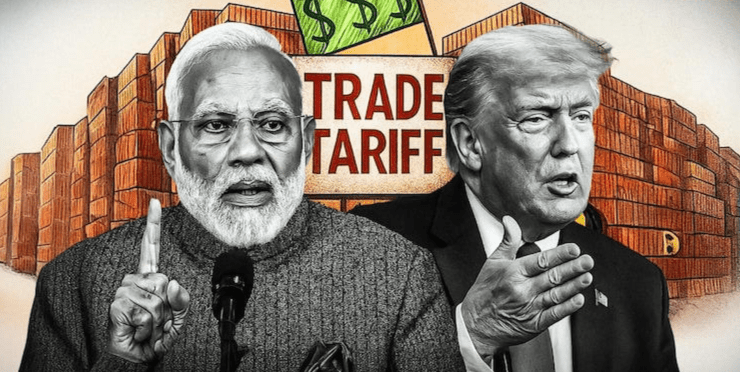
Is India really a “tariff king”? Not quite | Opinion
By Mohan Kumar, Former Indian Ambassador and Director General of the Jadeja MotwaniInstitute for American Studies
Courtesy: Ministry of External Affairs | Originally Published in Newsweek
The Myth of the “Tariff King”
India has long been portrayed, particularly in Western trade rhetoric, as a so-called “tariff king.” The argument goes that India’s import duties are prohibitively high, making it difficult for foreign goods to compete. But this claim doesn’t hold up to scrutiny. Unlike subjective measures—such as whether a country is considered “livable” or “hospitable”—tariffs are quantifiable, and the facts tell a more nuanced story.
Why Tariffs Matter in Developing Economies
To understand India’s tariff policy, one must first consider the role tariffs play in low-income, developing economies:
1. Protecting domestic industry: Especially important for “infant industries” that need protection to grow before competing with advanced global players.
2. Generating revenue: A crucial source of funds for governments, often applied to luxury or non-essential goods such as alcohol, cigarettes, or high-end motorcycles.
This framework has long been accepted by economists. Without protective tariffs, countries like India would have struggled to build domestic industries in manufacturing, agriculture, and technology.
India’s Reform Journey
It is true that India once had notoriously high tariffs. In the 1980s, average duties were some of the steepest in the world. However, this changed dramatically after the 1991 economic liberalization reforms and the Uruguay Round negotiations, which paved the way for the creation of the World Trade Organization (WTO).
Since then, India has steadily and systematically reduced its tariffs. The overall trend of the last three decades has been one of gradual liberalization, punctuated by targeted protection for sensitive sectors.
Applied vs. Bound Tariffs – A Key Distinction
When talking tariffs, two terms matter:
• Applied tariffs: The actual duties charged at the border when goods enter the country.
• Bound tariffs: The maximum tariffs a country is legally allowed to impose, under its WTO “most-favored-nation” (MFN) commitments.
The distinction is crucial. Applied tariffs reflect present-day reality. Bound tariffs show the outer ceiling, which countries rarely reach but keep as insurance.
By these definitions, India’s policies are squarely within WTO norms. Ironically, it is the U.S.—which has recently imposed unilateral tariffs on allies and rivals alike—that has often flouted WTO obligations.
What the Numbers Show
Critics usually point to India’s simple average tariff of 15.98%. On the surface, this does appear high. But it is a misleading measure because it treats every product equally—whether it’s a major traded commodity or an obscure item with little market share.
A more accurate indicator is the trade-weighted average tariff, which reflects the actual tariffs on goods that dominate trade. On this front, India’s tariff stands at just 4.6%—a figure well within global norms and far lower than what the label “tariff king” suggests.
Agriculture and Automobiles: The Protective Exceptions
India does maintain relatively higher tariffs in agriculture and automobiles. But the reasons are structural and compelling:
• Agriculture: Nearly half of India’s 1.4 billion people depend on farming, often on small, non-mechanized landholdings where agriculture is survival, not commerce. Asking India to dismantle tariff protections and allow heavily subsidized Western farm products to flood the market would devastate millions of livelihoods.
o India’s farm tariffs average around 33% for dairy, meat, fruits, and cereals.
o Compare this with:
▪ European Union: up to 205% on dairy, 261% on fruits and vegetables.
▪ Japan: up to 298% on dairy, 258% on cereals, 160% on meat and vegetables.
▪ South Korea: average of 54%, with peaks of 800% on vegetables and 300% on fruits.
o By this measure, Western countries are far more protectionist than India when it comes to agriculture.
• Automobiles: This sector is a major source of industrial growth and employment. Protecting it allows India to build domestic capacity and create millions of jobs. Tariffs here are not unusual—Japan, South Korea, and China also followed similar protectionist policies during their industrial rise.
Comparing with Peers
Even on the “simple average” basis, India’s 15.98% is not an outlier. Comparable economies maintain similar or higher levels:
• Bangladesh: 14.1%
• Argentina: 13.4%
• Türkiye: 16.2%
These countries have GDP per capita levels comparable to or higher than India, which underscores that India’s tariffs are well within the global norm for developing nations.
Tech and Electronics: A Low-Tariff Sector
One area where India is exceptionally open is technology and electronics. Contrary to U.S. complaints, India has 0% tariffs on most IT hardware, semiconductors, and computers. For other categories:
• India: 10.9% average on electronics, 8.3% on computing machinery.
• Vietnam: 8.5%–35% on electronics.
• China: 5.4%–20% on electronics, up to 25% on computing machinery.
• Indonesia: 6.3%–20% on electronics, up to 30% on computing machinery.
This shows that U.S. exporters often face equal or lower tariffs in India compared to Asian competitors.
The Bottom Line
Yes, India protects its agriculture, dairy, and automobile industries—and with good reason. But in other sectors, particularly technology and electronics, India’s tariff regime is as open as, or more open than, many of its peers.
With a trade-weighted applied tariff of just 4.6%, the claim that India is a “tariff king” collapses under the weight of facts.
Mohan Kumar is a former Indian Ambassador and Director General of the Jadeja MotwaniInstitute for American Studies at OP Jindal Global University.
The views expressed here are the author’s own.